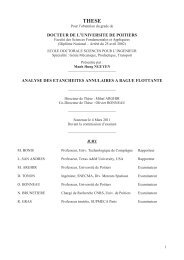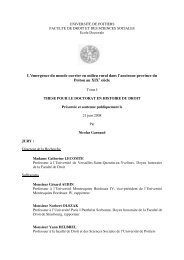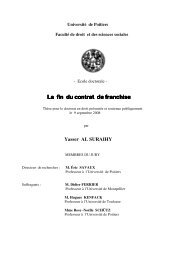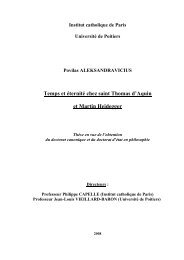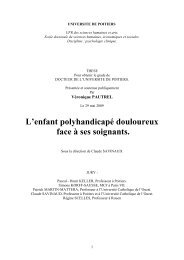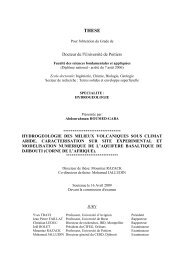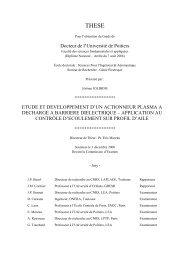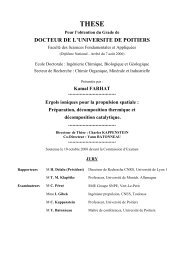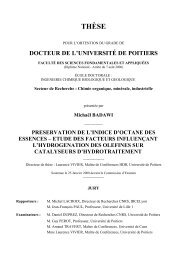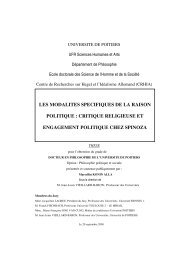Consulter le texte intégral de la thèse - Université de Poitiers
Consulter le texte intégral de la thèse - Université de Poitiers
Consulter le texte intégral de la thèse - Université de Poitiers
You also want an ePaper? Increase the reach of your titles
YUMPU automatically turns print PDFs into web optimized ePapers that Google loves.
CHAPITRE 5 – Expérience 2<br />
l’effet IC ? Sachant qu’aucune perturbation n’a été appliquée dans notre étu<strong>de</strong>, et partant du<br />
principe que seu<strong>le</strong> <strong>la</strong> pratique aléatoire induit <strong>de</strong>s processus inter-tâches, comment expliquer<br />
l’absence d’effet IC dû à <strong>la</strong> condition <strong>de</strong> pratique dans certains cas ?<br />
Dans notre étu<strong>de</strong>, nous avons testé <strong>le</strong>s hypo<strong>thèse</strong>s d’é<strong>la</strong>boration et <strong>de</strong> reconstruction (i.<br />
e., processus inter-tâches) en manipu<strong>la</strong>nt <strong>le</strong> facteur simi<strong>la</strong>rité <strong>de</strong>s tâches : processus<br />
additionnels d’é<strong>la</strong>boration et <strong>de</strong> reconstruction, respectivement dans <strong>le</strong>s Expérience 1 et 2.<br />
Ainsi, nous pouvons évaluer <strong>le</strong> rô<strong>le</strong> respectif <strong>de</strong>s processus d’é<strong>la</strong>boration et <strong>de</strong> reconstruction<br />
sur <strong>le</strong>s bénéfices liés à l’apprentissage <strong>de</strong> <strong>la</strong> tâche et au transfert d’apprentissage. Les résultats<br />
issus <strong>de</strong> l’Expérience 1 sont majoritairement en faveur <strong>de</strong> l’hypo<strong>thèse</strong> <strong>de</strong> reconstruction :<br />
aucun bénéfice lié aux processus additionnels d’é<strong>la</strong>boration sur <strong>le</strong>s performances en<br />
rétention/transfert. A l’inverse, dans l’Expérience 2, nos résultats sont davantage en faveur <strong>de</strong><br />
l’hypo<strong>thèse</strong> d’é<strong>la</strong>boration : détérioration <strong>de</strong>s performances en rétention/transfert liée aux<br />
processus additionnels <strong>de</strong> reconstruction. En résumé, nos résultats suggèrent que l’é<strong>la</strong>boration<br />
<strong>de</strong>s p<strong>la</strong>ns d’actions pourrait être en gran<strong>de</strong> partie responsab<strong>le</strong> <strong>de</strong> l’amélioration <strong>de</strong>s<br />
performances en rétention/transfert liée à <strong>la</strong> condition <strong>de</strong> pratique aléatoire comparée à <strong>la</strong><br />
reconstruction <strong>de</strong>s p<strong>la</strong>ns d’actions, même si, pour l’une comme pour l’autre, <strong>la</strong> seu<strong>le</strong><br />
é<strong>la</strong>boration ou reconstruction <strong>de</strong>s p<strong>la</strong>ns d’actions ne suffit pas à expliquer <strong>le</strong>s bénéfices<br />
observés sur l’apprentissage et <strong>le</strong> transfert d’apprentissage.<br />
Un point <strong>de</strong> vue théorique différent <strong>de</strong> celui <strong>de</strong>s hypo<strong>thèse</strong>s d’é<strong>la</strong>boration et <strong>de</strong><br />
reconstruction semb<strong>le</strong> éga<strong>le</strong>ment pouvoir fournir un support théorique pertinent : l’hypo<strong>thèse</strong><br />
<strong>de</strong> « chal<strong>le</strong>nge point » (Guadagnoli & Lee, 2004).<br />
Hypo<strong>thèse</strong> <strong>de</strong> « chal<strong>le</strong>nge point » (Guadagnoli & Lee, 2004) :<br />
Sur <strong>la</strong> base <strong>de</strong>s prédictions <strong>de</strong> Battig (1972 ; 1979), <strong>la</strong> condition simi<strong>la</strong>ire dans<br />
l’Expérience 1 s’apparente à <strong>la</strong> condition ayant <strong>le</strong> niveau <strong>de</strong> comp<strong>le</strong>xité <strong>le</strong> plus é<strong>le</strong>vé. A<br />
l’inverse, sur <strong>la</strong> base <strong>de</strong>s prédictions <strong>de</strong> Wulf et Shea (2002), <strong>la</strong> condition non-simi<strong>la</strong>ire dans<br />
l’Expérience 2 peut être considérée comme <strong>la</strong> condition ayant <strong>le</strong> niveau <strong>de</strong> comp<strong>le</strong>xité <strong>le</strong> plus<br />
é<strong>le</strong>vé (i. e., requiert <strong>la</strong> paramétrisation du geste selon 3 directions possib<strong>le</strong> vs. 1 direction dans<br />
<strong>la</strong> condition simi<strong>la</strong>ire). Les résultats observés dans <strong>le</strong>s conditions où <strong>le</strong> niveau <strong>de</strong> comp<strong>le</strong>xité<br />
est supposé <strong>le</strong> plus é<strong>le</strong>vé (i. e., condition simi<strong>la</strong>ire dans l’Expérience 1 et non-simi<strong>la</strong>ire dans<br />
l’Expérience 2) ne révè<strong>le</strong>nt aucune différence bloquée-aléatoire sur <strong>le</strong>s tests <strong>de</strong> rétention : <strong>la</strong><br />
pratique <strong>de</strong> tâches comp<strong>le</strong>xes pourrait « surcharger » <strong>la</strong> mémoire <strong>de</strong> travail, évitant ou tout au<br />
84



